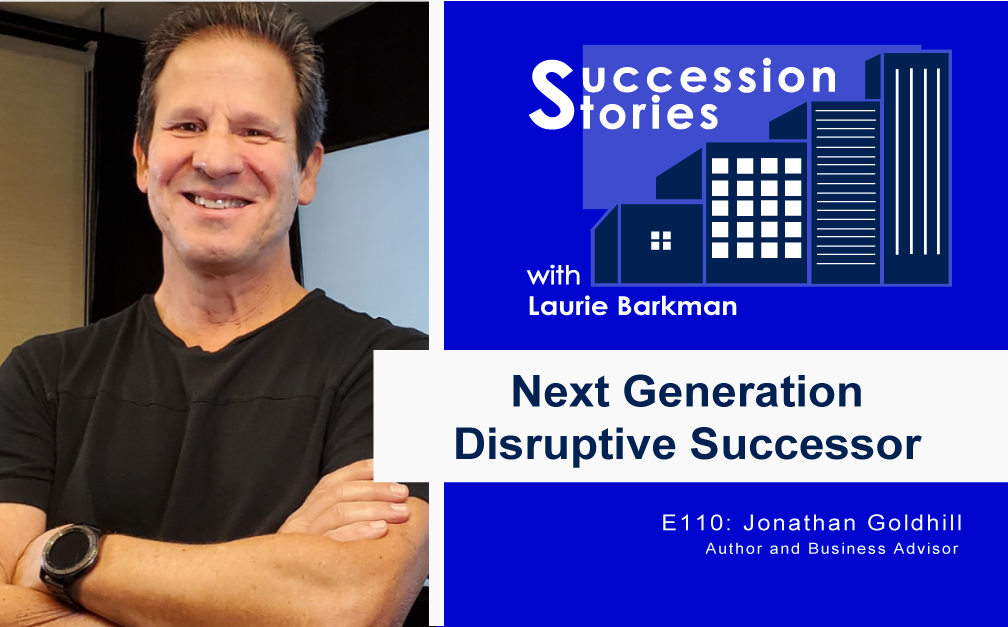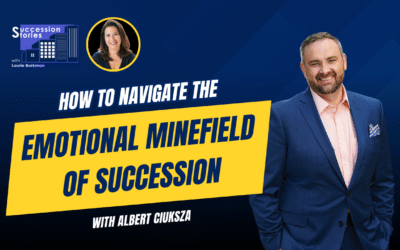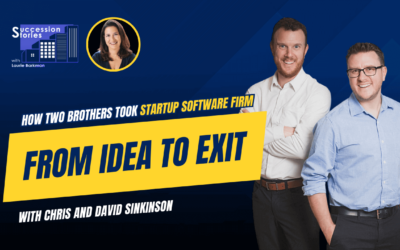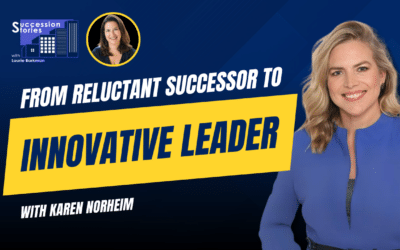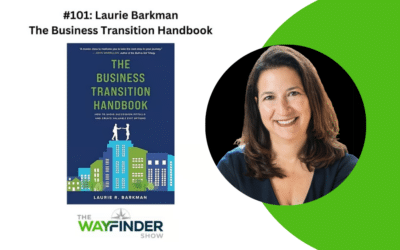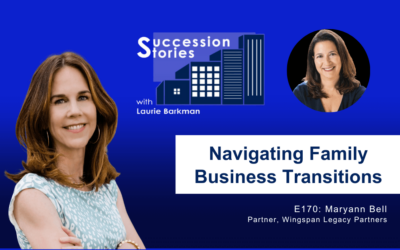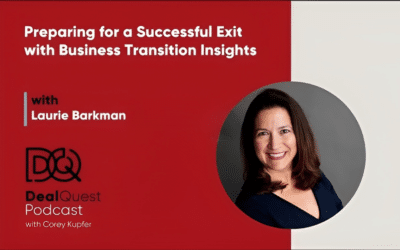Summary description
Innovation, transition, growth. These are the key drivers of disruptive succession that help businesses evolve and continue to thrive. This week on Succession Stories, Jonathan Goldhill joins Laurie Barkman for a conversation on moving businesses forward in the face of change. Jonathan is the founder of Goldhill Group which has been serving closely-held and family businesses for over three decades. Drawing from his experience as a strategist and consultant, Jonathan is also the author of Disruptive Successor: A Guide for Driving Growth in Your Family Business.
Listen in to learn more about:
- Evaluating potential partners prior to a partnership venture
- Challenges facing multi-generational succession
- Viewing succession from an outsider’s perspective
- Developing a business identity beyond the founder
- Building a team of trusted people to help the business navigate succession
- Effectively governing family businesses
Show link:
https://www.thegoldhillgroup.com
Connect with the host, Laurie Barkman on SmallDotBig.com and sign-up for an insights newsletter to build value in your company.
About Succession Stories Podcast
Succession Stories is an award-winning podcast hosted by Laurie Barkman, The Business Transition Sherpa– guiding business owners through the process from “transition to transaction.” Subscribe to Succession Stories and share a review if you enjoy the show!
Learn more at https://thebusinesstransitionsherpa.com
Book a 1:1 Advisory call at: www.meetlauriebarkman.com
_______________________________________
Become an Official Patron of Succession Stories Podcast:
https://www.patreon.com/lauriebarkman
_______________________________________
Is this the year to sell your company?
Don’t leave your exit to chance.
Stony Hill Advisors works with owners like you to get ready and maximize value when you’re ready to sell.
Visit www.stonyhilladvisors.com/podcast for a complimentary business valuation.
Transcript
Laurie Barkman:
Jonathan, welcome to Succession Stories. I’m so glad you’re here today. I had a great conversation with you on your podcast and I’m so glad to turn the mic around and bring you on here today.
Jonathan Goldhill:
Thanks a lot, Laurie. Glad to be here today.
Laurie Barkman:
I want to start with learning about your family’s business, Joseph H. Cohen & Sons. Tell us about the company, what they did, and its family business legacy.
Jonathan Goldhill:
Gotcha, so my grandfather and his two brothers and their father, Joseph, started a business really around the early 1900s. I have pictures that I’ve seen of my grandfather’s brothers aged 9, 11 and 13, selling men’s suits, three piece men’s suits for $9.99 if you can believe it, and hustling on the streets of New York to get those suits sold. Ultimately, they built this into a very large clothing manufacturing business. I think a big inflection point was in World War Two, when they supplied overcoats to the army, and I did a massive amount of orders.
Another inflection point was when they opened up a very large factory in North Philadelphia and in what is an urban Lee depressed area. There’s actually a huge blog post on God, I can’t even think, it’s not Reddit, but it’s one of those were a blog, where someone actually did an enormous research project. On the business. I learned almost as much from that, as I knew from growing up in it but my family was very successful in their business. When I went to visit my grandfather it was always in the heart of New York City. He always lunched at the fanciest place, which was the 21 Club and he had very fancy offices and they were basically executive offices with a showroom, I actually never walked into the factory but I understand that their factory had over 2000 employees, and over a million square feet of floor space in the United States, 500,000 of which was at, I think Lehi and Brode, in North Philly, and so this business was very successful.
The research that I came across suggested that they actually sold the business in 1969 so I was 11 years old and they got lifetime employment contracts as Chief Administrative Officer, Chief Executive Officer, and I mean, the three brothers, they worked in these offices until my grandfather was basically so far where his dementia was so bad that he really couldn’t work and so he died when he was 93, at 1992 and without any opportunity for me to work in that business. Like it would have been a great opportunity for me to have been a fourth generation entrepreneur, family business leader but there, a lot of the sons didn’t go into the business, none of the daughters went into the business at that time and my father, who was a son in law went into the business but I guess it wasn’t, they were, I don’t know, it’s not that it wasn’t that he was bloodline, but he passed away when he was 35 when I was two years old, so he died in 1960.
The business continued to go on and it really just closed down their doors in like the late 80s or 86 I think it was. They closed their doors in Philadelphia, because there wasn’t a successor to take it to a new place, because it really would have meant everything being offshore in terms of manufacturing. I mean, it would have been so disruptive to the way they currently did business and their business was a relationship business so I mean, it worked fine, when my great grandfather passed but by the time my grandfather and his brothers were passing, there really was no no one to take the torch at that point, but a very successful company.
Laurie Barkman:
Sounds like it. It’s so unusual to hear if they acquire say to the owners, you’ve got a lifetime employment contract. That’s like the Supreme Court of manufacturing. That’s amazing and it’s a sad story. I mean, it’s a successful story but then ultimately, it is a sad story that the company just closed at its peak. How big was it in terms of revenue?
Jonathan Goldhill:
I think the research that I came up with was that in ‘69, they did $30 million in revenue so that would probably be $350 million in today’s dollars.
Laurie Barkman:
That’s impressive, so you have an entrepreneurial gene and your family was handed down and you never worked there, as you said, but you got started with entrepreneurial ventures pretty much when you finished college, right?
Jonathan Goldhill:
Yes, an entrepreneurial and an artistic gene, I might add, my grandfather actually got up every morning, supposedly at 4am. went upstairs to his, one of his rooms where he painted and he painted for an hour before he went to work and actually, he was a prolific painter, and had a couple of shows at the Whitney Museum, probably mostly because he was friends with the owner and founder of the Whitney Museum who also owned the New York Mets at the time, whom he had baseball, like season tickets right behind her box so it was a quite impressive background.
Yeah, so when I got out of college, I, like maybe a lot of young people, wanted to change the world, glory, and I was idealistic enough to think that I could change the world and that my whole thing was about fighting for social and economic justice and that kind of morphed into, “Then well maybe I could do good while doing good,” mostly it was focused on doing good so I was involved in a lot of nonprofit, community-oriented cause-oriented activities, before I decided to get into a real entrepreneurial business on my own. That was an art and clothing business so in 1986 was six years out of college I thought to myself, actually, I ran into someone who was, I thought, a terrific artist, and very entrepreneurial, and he was doing his art on clothing, and calling it wearable art. Sometimes he would do it on fabric and canvases and furniture and I thought to myself, this might be it, like, this is me, doing clothing business, following the art that my grandfather did. My mom was my grandfather’s daughter, she also was an artist so I thought, this is something that’s in my blood and I partnered up with this guy, and I tried to borrow money, or get my family, my grandfather to invest and I got a letter from his accountant, basically saying, “Your grandfather’s really, like, he’s too old and he’s too basically senile to be able to even consider something like this. Wish you all the best in your venture and good luck and well, it’s a good thing you didn’t invest in that business,” Laurie.
Well, so this artist, who had basically grown up on the streets of Hollywood, pretty rough existence, turned out to be not that honorable of a person and he had kind of hoodwinked me into let’s open up a store, which I thought was a great idea and then let’s start going downtown and doing manufacturing and the store was a good idea, because down in the basement was a huge room to produce these hand painted, wearable art fashions and he and then an apprentice, and then a couple of apprentices, they were painting and doing really good stuff, until drugs entered the scene and, specifically, I think it was LSD and cocaine, and maybe it was even math, I don’t even know back then but he kind of went off the rails with his drug habit and I didn’t see it, and I wasn’t that well aware of it but like, he was determined to have me invest as much money as I possibly would invest and he would ride this out and so we had that going, then we jumped into let’s see if we can manufacture these things so that we don’t have to create create them one by one but that didn’t translate – handpainted stuff and manufacture clothes – like, there’s huge gap. It just didn’t work and then it was a few other things like a big opening that we did on the streets in Venice that attracted hundreds of people and where he painted women that were actually naked and did a boardwalk kind of way. We had a guy who was like a pro frisbee guy. We had a musician that we had signed as an artist, and we’re representing and he played and I just thought like this is a great party, but like this is like the beginning to the end. so it didn’t last past the summer in Venice. I came home and basically shut it down because I knew that it just was going to be a really bad investment.
Laurie Barkman:
It’s a cautionary tale about partnership. Yeah, you didn’t know that he was going to have you just be the banker?
Jonathan Goldhill:
No.
Laurie Barkman:
That he was going to be happy to spend your money.
Jonathan Goldhill:
No, and I didn’t also know that he had a wife and two children that were living in Maui, that then came over to Venice Beach, California, and started living also in the upstairs loft above this retail store so it turned into basically a crazy scene, because between the womanizing, the drugs, and the determination to spend whatever money I would put on the table, I thought, this is a really bad partnership. This is the difference between like a family business, probably and a non-family business. Had this been a family business, I would have probably known of his history, and I didn’t really know his history that well. I was just really captivated by his art. Everyone said, “Oh, my God, he does the best stuff,” he literally took like, great masters like Picasso and Ben, Shawn and Chagall and he interpreted these and he did them on T shirts and leggings and, and leather jackets and silk and I mean, he just painted everything, including naked women’s bodies and it was like, this is just too funny. It was a lot of fun but it was kind of reckless.
Laurie Barkman:
Yeah, probably not the business venture to move you forward; it was more like Studio 54.
Jonathan Goldhill:
Very much and it was at that time, it was the 80s when it was quite Tom Wolf.
Laurie Barkman:
Tell me about the bridge from where you were getting started in your entrepreneurial ventures to how you became an advisor to folks that you’ve defined as disruptive successors.
Jonathan Goldhill:
Yeah, so that lesson taught me that I needed to go back to business school and learn how business is really done and I sought out specifically USC University of Southern California, that is, because they had one of the top entrepreneur programs in the country and still do and from there, I got into the entrepreneur program, I was also really interested in management, consulting and family business so I took courses in those areas and then I went and worked for a consulting firm that was a small business consulting firm in the community that basically we’re choosing was a business and economic development firm and so I was involved in working with 10s, literally 1000s of businesses over the next 10 years. We grew that business, from three to 30-40 people from literally $100,000 that we borrowed from the chamber, and nothing in assets. We took it to a 10 million asset, $4 million company and then I decided I needed to go out on my own and I started advising small, and growing businesses, some medium size, some actually pretty large. Eventually, after doing this for like, 30 years, I look back and I said, ”Who are my best clients, and who are the clients I really liked working with?” and they were all family businesses and then I noticed that there were two types of family business members, there was the older, they were 55 to 70 years old, and they were great to sit around and talk with, but they weren’t particularly coachable.
Then there was this younger generation, and they were 25 to 40 and they were a successor that wanted to take over their parents business and what I found was, they were much more coachable and when they hired me, the assignment lasted much longer than assignment with the dad or mom parents might have lasted six months. The kid let’s call him Jr. wasn’t particularly as engaged when this when Jr would hire me, it would last for years and so that’s when I decided that’s my niche. I’m basically a scaling up growth coach. I’ve been involved in Entrepreneurial Operating System EOS and, and different communities of coaching and decided to write my own book called Disruptive Successor: A Guide for Driving Growth in Your Family Business and target that next generation leader that millennial 25 to 40 year old who really wants to two to 10x the business this made sense.
Laurie Barkman:
I think it really definitely makes sense and I can relate to it as I was thinking about this show and so for the fans that remember my trailer and the introductory comments about the show, and the inspiration of it was about this baton and what happens when the next generation gets the baton. A big inspiration for me was working for a third generation leader, who at the time was in his 60s so he had watched his grandfather founded the company, and then his father worked in it. With each generation, they did something different in the industry and this was a transportation logistics company. And it started out as a horse pulling vegetables and fruit, and then it was trucking and warehousing and then it was the birth of reverse logistics, which is a major part of a three PL industry.
I was reflecting on that and again, the inspiration for this show and the conversations that we have, because it’s about I think, innovation, growth and transition and the concept of a disruptive successor is so important in that because also, as we think about the corporate lifecycle, and we get to the maturity curve, that you can either go on the downside and let it continue to go down, or you’re going to pull back and come back to your entrepreneurial roots, which is difficult, right? We’ve talked a lot about the third generation, how difficult in the US it is to get to the third and then beyond that is even more challenging and one of my guests on the show had said that spouting whales get harpooned and that theme has recurred enough times that I wanted to ask you about it, your observations of the family dynamics when it comes to the next generation saying, “Okay, I’ve got the keys. I want to innovate, I want to do something different.” Does the leader – call it the parent generation – above give them truly the freedom to do that? Or do they hold back and say, “No, don’t screw it up?”
Jonathan Goldhill:
Yeah. Well, I think it’s really a very interesting question and I can only answer with anecdotal data and my anecdotal data is those parents who have relinquished the power or control or authority to their children and those children who have the entrepreneurial drive to take it to a next level, those have been clients that have stayed with me in excess of six months. On average, they’re 41 months so where they were when I last checked, so four or five years, I mean, I’m going on my eighth year with one of my clients right now and I’ve had several, that were eight year long engagements, the ones where the parent won’t let go, doesn’t hasn’t nurtured the confidence in their child, the, the child doesn’t have the confidence or the parent doesn’t believe the child can take over, those assignments have usually come from the parent.
After they’ve hired me to coach that person for six months, we sort of shook hands at the end and said, “Good luck,” like, I don’t think, I’m not sure they’re really ready and maybe they’ll be ready if they get more mature down the road. Maybe it wasn’t the right coat at the right time, or maybe they just weren’t ready. It’s hard to say, but I think it’s a big issue. If you’re going to transition a business to the next generation, then you have to treat that next generation, whether it’s family, or not family, even if you’re going to sell the business or pass it along, you have to look at that business from an outside perspective and you have to make yourself indispensable to the company and that is just like the hardest thing for a lot of entrepreneurs to do, because an entrepreneur, at least these types of entrepreneurs, created it not with the idea that they’re going to build it to sell, they built it to create maybe a certain amount of freedom in their lives. They built it around themselves and their abilities and their capabilities and they maybe don’t have a lot of trust in people and so not trusting people means they can’t let go and this trust, by the way, not just extends to their to their employees, but it extends to their family member, “I just don’t believe or trust that Jr.” I hate that term, but for lack of a better word, “that he or she is going to be able to make the right decisions.” Part of the challenge, Laurie, is that generally the predecessor is money that the successor is gambling with, most of the equity or assets or business or whatever. I mean, most of that is the predecessors’ business and money and assets. How many parents do you know that are willing to say to their kids, “Okay, you manage my money”?
Can you make decisions, because the 30 year old who has a long runway ahead of them in terms of life, they’ll bet the farm much more quickly than a person who’s 60, who’s looking at retirement is like trying to just make sure that this the seeds or whatever that seed corn, they have at the farmers going to fill their plate and take care of their mortgage for the next 15 or 20 years while they’re still remaining. I mean, so their risk tolerances are very different and that’s part of what makes it challenging so I think it’s risk tolerance but I think ego and control probably plays an even bigger part in why businesses don’t transition to the next generation, or at all.
Laurie Barkman:
Yeah, or at all. That’s a good point. A lot of companies don’t sell. Some people are surprised by that. There’s lots of reasons why that is, but if it’s not transferable, it’s not going to have value to another person or entity. There’s so many things we could unpack about what you just shared, Jonathan, the confidence in the next generation and the risk tolerance is a huge part of that, I wonder if it would be a different dynamic, let’s say from the founder versus the next gen, because if it’s not the founder, they’re at least a little more separated from that initial emotional tie as the founder, sometimes we can relate, there’s certainly more of a control element and letting go dynamic who can be a little more extensive versus the as you get further and further away from that founder emotional tie. Right? Do you think that that has anything to do with it?
Jonathan Goldhill:
I do. I don’t have as much experience in this area, because most of my clients are G2; generation two leaders but those clients that I can look back on were G2 leaders that had a son or sons and daughters in the business. If it had already transferred fairly successfully, from G1, G2, if G1 did a really good job of mentoring G2 and empowering G2 and giving them confidence, then G two has been mentored in a way that he or she can now mentor the next generation; G3 and so I think it’s so much about what we learn from our parents that we pass on. Nobody wants to think that they’re a lot like their mother or father, maybe because they want to think that they’ve sort of gone out on their own and done it better, done it differently, but I have to say, I mean, I don’t think I’m a lot like my mother and sometimes it really irritates me that I’m like that but I think that we are and so I think it just a lot of it just comes down to how well or how were you mentored by your parent before you.
Laurie Barkman:
Absolutely. In your book, we read your book, and I appreciate you sending me a copy, it was a really good read and some of the concepts are the nuts and bolts of running a good business, how to make your business, a better business and more enjoyable business to run and that’s a good message for anyone, whether you are the person who just bought the company, and you’re gonna now run it as the disruptive successor from the outside. Or if you’re a family, it’s a good idea to have a more healthy business, and you provide a lot of insights around how to do that. It strikes me that there’s sort of two paths here. One is, “I’m going to run this business more successfully, because I’m mindful of the next generation,” or “I’m going to run this business more successfully, because I might want to sell it one day to a third party.” Do you think that family members have an openness to that fork in the road? Are those options? Or do they really just pick a path and go?
Jonathan Goldhill:
I think they do. They think there’s an awareness that that they took over this business that was not really sellable, but it was transferable to the the children, and that the children being really involved, have built it into a business that has more scalability, it’s got better systems, it’s got better people that are proxies, it’s larger. Because if they’ve been working with me for eight years, they’ve probably 10x The business by now and that means even if they started with 10 or 15 employees, they’ve got 150 – those are the most most of the clients I work with, by the way, they come to me by the time when they’re between 10 and 50 and they’re starting to put these processes into place and when they leave, they’re a couple of 100 or more, so I think that they’re looking at, “How do I build real value?”
I think also, when they’re transferring the equity, and it’s not just been gifted to them, especially when they have to buy it, or they have to earn it, they understand what the business’s value is because they’ve been through a formal, probably valuation process and so they now know what it’s going to take to get it to the next level. Some people will just take it and keep it at that level, but then they basically bought a job. I think you said it really well earlier, when you said, if they’re going to be a disruptive successor, they have to be either involved in innovation, transition, or growth, you know, are all three and so, like you talked about the transportation company, I mean, you’ve got to innovate. Innovate in the business model, you certainly have to innovate in technology, because that didn’t even exist before, you know, all the systems that you would put in that area. If you’re going to have more families involved in the business, then you’re going to need growth, because you got more like $100,000 plus a year salaries to feed and families to feed so you got two or three extra business just for each family. That unit that comes in and in the transition process is also part of that process. I don’t cover it as much in my book, but like a sidecar book that would go along with my book to talk about, how does equity get transitioned? Is it through purchases through gifting? Is it through a combination? How do you evaluate what it’s worth when you transfer all those things, and all the emotional issues that come up for either a founder or the predecessor and letting go, so these are all important issues.
Laurie Barkman:
I think that would be a good sidecar book.
Jonathan Goldhill:
You could read that book. Laurie,
Laurie Barkman:
I can write that book with you. Let’s talk about the role of governance, the family shareholders, a family board. What are some characteristics of a family board? What are some examples of when it’s been used effectively or ineffectively in your experience?
Jonathan Goldhill:
Yeah, so with most businesses that are just one – where there’s only first and second generation, the family board is just basically the immediate family members, or anyone who’s involved in the business that’s been invited in, it’s when it starts to get to G3 and G4 and beyond, this is, I’m sure, where you have more experience, I think, than I, where you’re starting to now bring in outside people who are advisors. It’s one thing to have an advisory board where people are just basically giving their input and maybe they’re being paid or compensated for it but then they’re not an officer of the corporation. It’s a different thing when they’re a board member, and they’re an officer of the corporation and now they’ve got, like an elevated level of fiduciary duties that they need to be accountable and responsible to. I mean, I would say that, and putting together whether it’s an advisory board, or a board, you should look at the complementary skills and talents of the members of the board. Do you have someone who’s good in finance, you have someone who’s good in people issues? Do you have someone who’s good in operational processes? Do you have someone who’s from the industry? Do you have people who have built successful companies that are in other industries? I think a mix of those and family members who are going to be a part of it makes a lot of sense but you have to really look at the diversity of the board and I don’t mean just male, female or younger, older, it’s really more experienced and what they bring.
Laurie Barkman:
Absolutely, I recently, about a year ago, went through an interview process for a Family Advisory Board. Like you said, it’s not a fiduciary board, it’s an advisory board but that’s what they were looking for. They were looking for different experiences, what each of us would bring to the table. It’s a second generation construction company and so being second gen, right, to your point earlier, it has some interesting dynamics to it but it is an effective way to try to help get to that next level and there are just rough benchmarks. What I’ve heard is when, let’s say a company gets to around 40 million is when they might want to consider having an advisory board is that about what you’ve seen.
Jonathan Goldhill:
I think that makes a lot of sense. I think I’ve had clients who have been smaller who have tried it, but they’ve mostly fizzled out. There just isn’t enough there maybe in terms of strategic direction or input or, or finances to cover it so that sounds about right to me.
Laurie Barkman:
Okay. When I was on your show, the Disruptive Successor podcast, one of the phrases that has stuck with me, I loved it, the boat, building your boat, business owners advisory team, just the analogy is so good, who’s in your boat with you and you and I aim to be in that boat together to help to help business owners be successful and get ready for transition so I wanted to just address that you work with business owners on this journey to help them grow and scale and at some point, they’re going to consider this proverbial fork in the road of what to do next to transition to family to sell to a third party. At what point and this is a question I get all the time so I’m just asking you because I want to compare, what’s the timeframe look like? Do you think are people starting to think about that 10 years out five years out from when they personally are ready to make an exit? Do you see different dynamics and different types of companies maybe that you’re working with a lot of second gen, so maybe there’s more consistency there?
Jonathan Goldhill:
It seems to me that the standard rule of thumb is three to five years out is a good planning timeframe. This is enough time to be able to double the business and we know, you and I know both as value builder advisors, that a business that is generating 20 million versus 10 million, is going to be more than twice as valuable, just because of the size, the larger the business is. Typically, I think, the larger the multiple will, that will go along with it and I think that a lot of people come to me in the past, and they’re much further down the road, and they wait till it’s six months or 18 months and it’s harder to move things at that point in time, it takes time to make change and and accompany. If they come to you within six months, then you’re just putting, as I think the phrase is, you putting lipstick on a pig, if it’s a mess of a company, so I think a longer planning cycle is needed but unfortunately, I don’t have the data at my fingertips. Laurie, you might, but the vast majority of companies don’t ever transition or six or sell, they probably just shuttered their doors and that’s probably because the vast majority of businesses are small businesses, I mean, supposedly 96% of all businesses, they maybe this data is old, but they were under a million dollars in revenue and they were a mom and pop in we’re talking about the grocery store the dry cleaner, and maybe more of these do sell than I realized, but there’s quite a few businesses that go to market to sell, and actually don’t ever close a deal.
Laurie Barkman:
That’s true. Yeah, and the types of businesses you’re describing, we call main street businesses, the under a million, it’s definitely more call it owner led more of a job, so to speak and they’ve never really intended to transition to anyone else and then they just typically close. Many of these companies don’t have a successor so that’s a natural next step is that it’s going to liquidate because there is no successor and if they die, then of course, it’s going to just close. Those are some of the dynamics for the companies that do want to sell, and they put it on the market, and what would be some of the reasons that it doesn’t sell? Well, it’s kind of a matching problem. Did anyone find it, that would be a fit, and that could be part of the gap? But if it’s a company that’s not generating a lot of cash flow profits, if it’s too reliant on its owner, those are also some of the risk risk natures of it and is it bankable?
There’s a lot of reasons why a business wouldn’t sell; is it really transferable, and in the eye of the buyer, is it going to generate the value that warrants the price? So many times it doesn’t sell also because the sellers expectations are just too high and it’s just not realistic and so they decide to keep holding on, keep holding on and then of course, one of the other tragic things might happen along the way, so yeah, I do advocate on this show and with my clients that when time is on your side, to work on your transition planning, and for the good reason, as you described, if you can double your business in five years, I mean, it’s just it’s worth it to invest that time and get your return on equity and return on assets that you’re looking for and also, just to your point about the data you mentioned, the larger the company, the the higher the multiples and a really interesting chart that I have shows an inflection point, quite literally, at 25 million in revenue, the chart was pretty flat up until that point starts to increase and then at 25 million, the multiples just started to really kind of go up exponentially so if that point is definitely backed up.
Jonathan Goldhill:
Yeah, sure. For sure we were talking about, it’s a mindset, right, Laurie, it requires a different mindset, to build a business that’s seller ready or buyer ready, whatever the phrase would be, right, and so it’s a mindset to look at your business, or to be able to look at your business from the outside and look in and say, “What’s this business worth?” I think it’s really important for owners, if they don’t have that objectivity, to talk to someone like yourself, or me, and get some input or feedback and so I went into a business just recently, to a client of mine, and they’re wanting to grow and I said, like, “Your place is a mess.| It’s like a manufacturing technology business and I said, “Did you clean your business up? You wouldn’t even invite a customer or prospective buyer into your business,” so if your business doesn’t look good, it’s not attractive. I mean, think of the house that sells fastest. It’s the one that has great curb appeal. I know what I’m always looking at buying a house; I’m looking first at the pictures, how good are they? How good is the photography? How good does it look from the curb? If it doesn’t have good curb appeal, and if it’s a mess inside, if it’s cluttered it’s not gonna probably sell, neither is your house, by the way, so declutter your business, clean it up. Make it look like it’s something that is really attractive. I mean, it just makes sense.
Laurie Barkman:
It’s figurative, but it’s literal to write the scorecards, the performance metrics of the business, getting the metrics, looking the way they should directionally look. We’re looking at trends, we’re looking at your future, projections, all those things matter and yes, the physical space matters too. Walking through warehouses when there’s a well organized, safe environment versus when there’s not. I have a client that right now when he shows his warehouse, it is so well organized, well labeled. It’s impressive and so the most common comment has been, “Well, we just haven’t seen this before and it doesn’t make a difference.” Yeah, it makes a difference.
Jonathan Goldhill:
I’ll give you an example of how the profitability of a company that’s organized like that, it’s always been the case, that when I go and see a company that’s super neat, super organized, charts and metrics posted outside of cubbies or in hallways, or the values of the company really prominently posted. It’s always the case that that company is so much more profitable than its competitive company so don’t think cleaning your your business up is just about, like, it’s a time waster and we don’t have time to do that. You need to think about cleaning up the business, because the simpler and more elegant and more organized your businesses, the more sellable it’s going to be.
Laurie Barkman:
Absolutely, so winding down, I know you have lots of great quotes in your book and I bet that you have a favorite one that you could share with us.
Jonathan Goldhill:
One of my favorite quotes is by Buckminster Fuller, and he was a systems thinker and an architect and he was kind of a little bit of a wacky guy. He came up with something called the geodesic dome, which he thought was going to be the ultimate living place but the quote I use is, ‘if you want to teach people a new way of thinking, don’t bother trying to teach them. Instead, give them a tool, the use of which will lead to new ways of thinking’ and I have found that the silver bullet tool in my arsenal has been giving people what I call the vital few trivial many. It’s basically practicing the 80-20 principle and it literally will teach you how to delegate and or delete or downshift on some activities so that you can elevate yourself because you really always should be training your replacement and so for successors predecessors, if you’re not training your replacement, and if your replacements aren’t training, their replacements, your business is going to be limited in how much it can scale, so that’s my favorite quote – Buckminster.
Laurie Barkman:
It’s a great quote, it’s a great takeaway and I think, super ending message here for folks for not only disruptive successors, but anyone working in their business that wants to increase value, whether it’s for Exit Planning in the next three to five years, or thinking beyond that, because if we can run more profitable businesses, we will enjoy it more, we’ll have a more healthy environment for ourselves and also for our families and for our employees.
Jonathan Goldhill:
Exactly.
Laurie Barkman:
Well, Jonathan, thanks so much for being on if people want to get in touch with you, what’s a great way for them to do that?
Jonathan Goldhill:
Yeah, so the best way is to go to my website and that’s thegoldillgroup.com, pretty easy to spell. From there, you can access my book, you can access my podcast and you can learn more about me and you can contact me and schedule a call with me.
Laurie Barkman:
Awesome. Jonathan, thank you so much for coming on today. It was a joy to talk to you and I know we’ll be continuing the conversation.
Jonathan Goldhill:
Thanks, Laurie.
Laurie Barkman:
So listeners, thank you so much for your support. You can always catch Succession Stories on any of your favorite podcast players or of course on YouTube. Don’t forget to like and subscribe to the show that really means a lot to us. If you want to maximize the value of your business and plan for future transition, reach out to me for a complimentary assessment at meetlauriebarkman.com. Join me next time for more insights from transition to transaction. Until then, here’s to your success.

